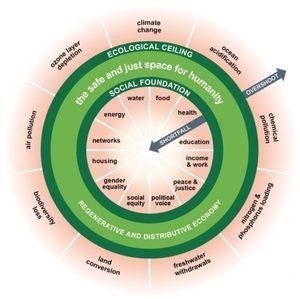General Resources
Description
Introductory resources and reference materials to help acquaint you with the issue of materials and waste.
Share this Subissue on:LinkedIn
Resources
The Social Foundation: 'A Safe and Just Place for Humanity'
Kate Raworth's “Doughnut” model is a key framework for understanding sustainability context. Building on the planetary boundaries framework as a 'ceiling', it adds social foundations as a 'floor' and underlines the need to operate in the space between. The social foundation is made up of 11 boundaries that draw attention to communities needing access to basic resources to fulfill their human needs. This access needs to be achieved in a way that does not place undue stress on the earth's resources. The framework is based on the premise that we should be striving to build and maintain social foundations while staying within planetary boundaries.
Global Resources Outlook 2024
This comprehensive resource from UNEP can help you to understand how resources are essential to achieving the Sustainable Development Goals and tackling the polycrisis. Building on more than 15 years of work by the International Resource Panel, including scientific assessments and inputs from countries, stakeholders in the field, and regional experts, the report illustrates how rising trends in global resource use have continued or accelerated, and maps out how demand for resources is expected to continue increasing in the coming decades. It explains why sustainable resource management is urgently needed, and highlights the transformative actions that the global community must immediately pursue. This resource will be beneficial to a wide spectrum of sustainability, procurement, and strategy professionals.
Global Material Resources Outlook to 2060: Economic Drivers and Environmental Consequences
This comprehensive report from the OECD presents global projections of materials use and their environmental consequences, providing a quantitative outlook to 2060 at the global, sectoral, and regional level. It explains the economic drivers determining the decoupling of economic growth and materials use; provides projections of economic baseline scenarios, economic drivers of materials use, primary materials use, and of recycling and secondary materials; and features case studies on demand and supply risks for specific materials. This report will be especially beneficial to sustainability and procurement professionals.
What a Waste 2.0: A Global Snapshot of Solid Waste Management to 2050
This comprehensive report from the World Bank features extensive data on global, regional, and urban trends on solid waste management, from technical and operational trends to environmental and social impacts. It estimates and projects waste generation to 2050, and provides information on waste generation, collection, treatment, and disposal; emerging regulations and technologies; citizen engagement; and more.
The database linked with this website also includes information on 200+ countries and economies, as well as more than 360 cities.
Global Waste Management Outlook
A joint effort between the United Nations Environment Programme and the International Waste Management Association, the Global Waste Management Outlook (GWMO) is an impartial, in-depth assessment of global waste management. The GWMO evaluates the potential that superior waste management can provide industries and communities in meeting future sustainability challenges. This resource draws upon scientific knowledge and the work of leading experts to provide information on trends, analysis of governance and financial mechanisms, and policy advice, and features tools for taking a holistic approach towards waste management. The GWMO also sets forth Global Waste Management Goals and a Global Call for Action. These complement the SDGs, and can support your company in recognising waste and resource management as significant contributors to sustainable development, resilient communities, and climate change mitigation.
Zero Waste International Alliance
Established in the early 2000s, the Zero Waste International Alliance (ZWIA) promotes positive alternatives to dumping, landfills, and incineration, and raises awareness of the benefits of viewing waste as a resource that can benefit business. Operating at the international, national, and local level, the ZWIA provides definitions and standards for the application of zero waste goals and initiatives; facilitate research and information-sharing; build capacity to effectively implement zero waste; and connect change agents with leaders in the field to help achieve zero waste outcomes.
International Solid Waste Association
The ISWA is an independent, non-governmental, non-profit association that promotes and develops professional waste management worldwide. ISWA issues publications on waste management and related research; raises awareness of global waste emergencies; and offers education training programs, information development, and technical assistance at the global level.
The Higg Index
This is an open-source set of assessment tools from the Sustainable Apparel Coalition developed for apparel and footwear companies to assess the sustainability of their value chain. It is intended to enable companies to standardize how they assess their sustainability performance.
GRI 306: Waste
The GRI Standards enable organisations of all sizes to better understand and report on their impacts on the economy, the environment, and peoples, and in comparable and credible ways. GRI 306 can help you to disclose information on how your organisation prevents waste generation and how it manages waste that cannot be prevented, both within your operations and across your value chain.








